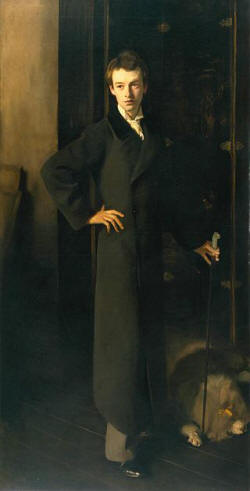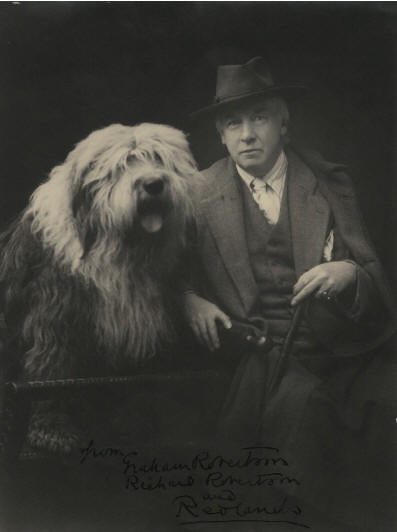Partner Arthur Melville, Kenneth Grahame
Queer Places:
9 Argyll Rd, Royal Arsenal, London SE18 6SE, UK
47 Melbury Rd, Kensington, London W14 8AD, UK
 Walford
Graham Robertson (8 July 1866 – 4 September 1948) was a British painter,
illustrator and author. He donated over 20 works of art to the Tate Gallery,
London.[1][2][3][4]
“In the London of Beardsley and Beerbohm, Shaw and
Henry James, Robertson was a
promising presence in the art and theater worlds. Today the museums of England
owe a debt to his taste and judgment”, according to The New York Times. He was
an important collector of art, especially William Blake. He wrote plays,
novels and a memoir, Time Was. He painted and illustrated books. He designed
costumes for Sarah Bernhardt and Ellen
Terry. He was twice portrayed by John
Singer Sargent. He was sociable, and knew many notable people including Oscar
Wilde and artists. He was a source of witty quotes and anecdotes. The New
York Times printed a biographical article about him in 2001.[5][6]
According to Cardiff University Professor Emeritus Peter Hunt, Robertson
shared a house in London with the author Kenneth
Grahame, while Grahame's wife and son lived in Berkshire.[7]
Walford
Graham Robertson (8 July 1866 – 4 September 1948) was a British painter,
illustrator and author. He donated over 20 works of art to the Tate Gallery,
London.[1][2][3][4]
“In the London of Beardsley and Beerbohm, Shaw and
Henry James, Robertson was a
promising presence in the art and theater worlds. Today the museums of England
owe a debt to his taste and judgment”, according to The New York Times. He was
an important collector of art, especially William Blake. He wrote plays,
novels and a memoir, Time Was. He painted and illustrated books. He designed
costumes for Sarah Bernhardt and Ellen
Terry. He was twice portrayed by John
Singer Sargent. He was sociable, and knew many notable people including Oscar
Wilde and artists. He was a source of witty quotes and anecdotes. The New
York Times printed a biographical article about him in 2001.[5][6]
According to Cardiff University Professor Emeritus Peter Hunt, Robertson
shared a house in London with the author Kenneth
Grahame, while Grahame's wife and son lived in Berkshire.[7]
In 1894 John Singer Sargent made a full-lenght portrait of the queer London
aesthete W. Graham Robertson (author of Pinkie and the Fairies), where
Robertson came out as adoringly idealized. He was twenty-eight when he posed for
the portrait together with his eleven-year-old poodle, Mouton. Sargent completed this work at the
height of summer, but insisted (despite his sitter's obvious discomfort) that
Robertson wear a long, thick overcoat throughout each studio session. "Then I
can't wear anything else," the younger man answered, stripping off almost
every other piece of his clothing, "much to the satisfaction of the artist,
who used to pull and drag the unfortunate coat more and more closely" around
him "until it might have draping a lamp post." During one lenghty session,
when Robertson grew faint from holding his pose for such an extended period,
Sargent grabbed him by the collar and rushed him into the street, seeking to
revive him with fresher air. "It was a pity that Oscar Wilde opposite was not
looking out the window," Robertson later recalled, "the "wonderful
possibilities of Tite Street" were yet unexhausted."
Born in London from a wealthy family Walford Graham Robertson eventually
dabbled in many forms and styles starting from Pre-Raphaelite oils to
illustrations, caricatures, to portraits, later impressionistic landscapes, as
well as being a talented writer. He was deeply interested in the theater and
by the age of thirty had designed costumes for five major plays of which he
received praise. He also painted many portraits of his friends and the leading
actresses of the time. Encouraged in artistic pursuits by introductions to Walter Crane, Thomas Armstrong and
Edward Burne-Jones; trained with Albert Moore and at National Art Training School, South Kensington; exhibition debut New Gallery 1889; member New English Art Club 1891 and Royal Society of British Artists 1896; solo exhibition Carfax Gallery 1906 followed by election to the Royal Institute of Oil Painters 1910; paintings comprise imaginative Symbolist subjects, landscapes and portraits, including that of Ellen Terry; designed sets and costumes for many stage productions in New York and London 1890–1900s, including Wilde’s Salome for Sarah Bernhardt and Undine and Pelleas and Melisande for Mrs Patrick Campbell; his own play Pinkie and the Fairies (1908) was a notable success; close friend and studio companion of painter
Arthur Melville, as well as a collector and student of William Blake’s works.

by John Singer Sargent

Mrs. Graham Moore Robertson
by John Singer Sargent -- American painter
1894
Watts Gallery, Compton, Surrey, England
Oil on canvas

Walford Graham Robertson
by Frederick Hollyer
Platinum print, circa 1890-1893
5 3/4 in. x 4 in. (146 mm x 102 mm)
NPG P47

Walford Graham Robertson with his dog Richard Robertson
by John Henry Muddle
bromide print, 1926
8 in. x 5 7/8 in. (203 mm x 150 mm) overall
Given by F.H. Bentley, 1963
Photographs Collection
NPG x22063

Ellen Terry
by Walford Graham Robertson
Oil on canvas, 1923
48 1/4 in. x 30 1/8 in. (1224 mm x 765 mm) overall
NPG 3132
Although he showed a lot of talent, he apparently never stayed with
anything for very long. It seemed the art-form he was best at was the art
of Schmoozing. He reveled in moving within social circles, was good friends
with Burne-Jones and avidly collected Pre-Raphael art. By the time Sargent
paints him as a London dandy -- he pretty much hits the nail on the head.
When John asked him why he had never painted a self-portrait, Graham
responded, "Because I am not my style." It's my impression that Graham liked
to think of himself as the English equivalent of the Comte Robert de
Montesquiou, whom he was also friends.
He retreated from the modern world in later life, living without electricity
or piped water in Surrey; died 4 September 1948.
My published books:


BACK TO HOME PAGE

 Walford
Graham Robertson (8 July 1866 – 4 September 1948) was a British painter,
illustrator and author. He donated over 20 works of art to the Tate Gallery,
London.[1][2][3][4]
“In the London of Beardsley and Beerbohm, Shaw and
Henry James, Robertson was a
promising presence in the art and theater worlds. Today the museums of England
owe a debt to his taste and judgment”, according to The New York Times. He was
an important collector of art, especially William Blake. He wrote plays,
novels and a memoir, Time Was. He painted and illustrated books. He designed
costumes for Sarah Bernhardt and Ellen
Terry. He was twice portrayed by John
Singer Sargent. He was sociable, and knew many notable people including Oscar
Wilde and artists. He was a source of witty quotes and anecdotes. The New
York Times printed a biographical article about him in 2001.[5][6]
According to Cardiff University Professor Emeritus Peter Hunt, Robertson
shared a house in London with the author Kenneth
Grahame, while Grahame's wife and son lived in Berkshire.[7]
Walford
Graham Robertson (8 July 1866 – 4 September 1948) was a British painter,
illustrator and author. He donated over 20 works of art to the Tate Gallery,
London.[1][2][3][4]
“In the London of Beardsley and Beerbohm, Shaw and
Henry James, Robertson was a
promising presence in the art and theater worlds. Today the museums of England
owe a debt to his taste and judgment”, according to The New York Times. He was
an important collector of art, especially William Blake. He wrote plays,
novels and a memoir, Time Was. He painted and illustrated books. He designed
costumes for Sarah Bernhardt and Ellen
Terry. He was twice portrayed by John
Singer Sargent. He was sociable, and knew many notable people including Oscar
Wilde and artists. He was a source of witty quotes and anecdotes. The New
York Times printed a biographical article about him in 2001.[5][6]
According to Cardiff University Professor Emeritus Peter Hunt, Robertson
shared a house in London with the author Kenneth
Grahame, while Grahame's wife and son lived in Berkshire.[7]





